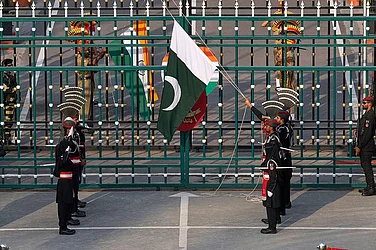Recently, the 50th anniversary of Satyajit Ray’s PatherPanchali was celebrated in the nation’s capital with the screening ofsome of his most memorable films. What was truly amazing was the massive crowd-- comprising lots of youngsters, some of whom came with their parents whoperhaps had seen these films in their younger days -- which attended this filmfestival braving the mid-day heat and gave a standing applause to each one ofthose films. These included the Apu Trilogy, Charulata and Pratidwandi.But it is the rapturous response to Pather Panchali that tells aninteresting story of its own.
Here was a metropolitan audience soaking in the pastoral sights and sounds ofvillage life in West Bengal -- a way of life that is a distant memory for mostof them. Movie buffs, of course, savoured re-viewing some of the classic scenesfrom Ray’s first film like Apu watching for the first time a train comingaround the bend, the first intimations of rain, the sweetmeat seller’s walkthrough the village and so on. But 50 years down the road, what is fascinatingindeed is Pather Panchali’s continuing appeal to an audience that istwo to three generations away from any connection with the countryside ingeneral.
Fifty years is indeed a lot of time for this process to have worked itselfthrough in terms of the shift of population from the country to the towns andcities of India. And one obvious consequence has been a steady decline, if notvanishing of rural settings altogether in popular cinema of the Mumbai variety.Very few of the recent crop of blockbuster Hindi films, for instance, have apastoral setting beyond the shooting of individual song sequences, say, in themustard fields of Punjab’s countryside. It is the concerns of an urbanaudience that is kept in mind by such filmmakers in recent times.
But metropolises are only small islands in a largely rural hinterland. Manyin the urban middle class are a few generations away from the land but the factremains that India is still an agrarian economy. Notwithstanding decades of postIndependence development, it is "one of the few examples left in the world ofan enormous population still largely dependent on agriculture" to borrow anexpression of Eric Hobsbawm. While many progressive changes have, no doubt,taken place on the economic front, India remains an exception to what he termedas "the most dramatic and far-reaching social change the world has experienced"in the second half of the 20th century.
This refers to the death of the peasantry -- a process that is coterminouswith what is termed as modern economic development. The movement away fromagriculture towards industry and services thus has occurred in most of thedeveloped nations of the world. In fact, in many of them, the share ofpopulation living off the land is less than 5-10 per cent. Given thefar-reaching nature of these changes, textbooks on development consider theshare of population dependent on agriculture as a yardstick of development.Accordingly, a high share implies that a particular country like India(including China and many African countries as well) is in the ranks of thedeveloping nations.
The land is, no doubt, emptying itself and filling up the towns and cities ofIndia. But the pace is not that rapid as has been observed in developedcountries like Finland and other Scandinavian nations in which this historicshift took place within a single generation itself. In sharp contrast, the shareof population living off the land in India for long remained stuck at 70 percent, subsequently declining to 57 per cent in 1999-2000 despite signs ofacceleration in the pace of urbanization and the memory of any connection withthe land receding with every succeeding generation.
Mumbai film industry, for its part, fast-forwarded this process andconsidered the transition over in the 1960s itself when it showcased the last ofits superstars who were comfortable acting in both rural and urban settings. Butthe reality instead is of long periods of stasis in this transition. The shiftto the towns and cities, no doubt, gathered momentum but the share of populationliving off the land started trending down much later. That proportion declinedto 63 per cent in 1983, then remained unchanged at 60 per cent between 1987-88and 1993-94 before heading down to 57 per cent at present. The moral of thestory is that the peasantry here is far from dead but is very much alive andkicking.
India thus remains very much an agrarian economy although the share ofagriculture in the country’s gross domestic product (GDP) has steadilydeclined to 24 per cent. When the share of those living off the land declinesless sharply than the sector’s share in GDP, the result is bound to be adecline in agricultural output or income per head over time -- a process ofimmiserisation which would only have gathered momentum in the context of thenear-stagnation of agricultural employment since the 1990s. The movement fromthe country to towns and cities is bound to accelerate under thesecircumstances.
But what does all of this have to do with Pather Panchali’s appealto a metropolitan audience even after 50 years of its making? One wonderswhether Akira Kurosawa’s Rashomon would have drawn a comparable crowdin the land of its making, where he is largely forgotten? Despite having noconnection with life in the countryside, the audience in Delhi was simplymesmerized by Ray’s mastery in holding a clear mirror to life. One needn’tgo as far as some critics that this film was indeed the best that he made, butit is a timeless classic. By thronging to the festival in droves, the audiencewere only paying homage to a master who ranks among the greatest filmmakers ofour times.
N Chandra Mohan is an economic commentator
















